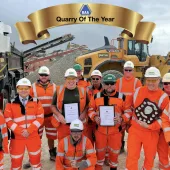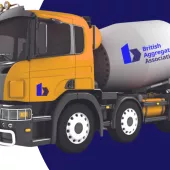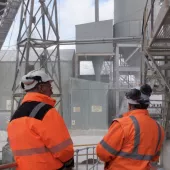BAA Annual Conference 2022: Part 1

First published in the July 2022 issue of Quarry Management
First of two instalments on the proceedings of the British Aggregates Association’s annual conference at the Palace Hotel, Buxton
There was a distinct feeling of a return to normal as the British Aggregates Association (BAA) held its annual conference at the Palace Hotel in Buxton, Derbyshire, on Monday 20 June, the day before the Hillhead exhibition returned to Hillhead Quarry just outside Buxton. The show is normally held every other year at the quarry but did not take place in 2020 during the Covid outbreak. This year it returned, and the sun shone. A full report about the exhibition can be found elsewhere in this issue of Quarry Management and on the Hillhead website.
And just as the crowds returned to the exhibition, so the number of BAA members who attended the organization’s 2022 conference was swelled by an easing of concern about Covid-19. However, the members got a reminder from Adrian Jurg of the Health and Safety Executive (HSE) that the pandemic is not over and that HSE inspectors would continue to monitor minerals extraction sites for compliance with health and safety regarding Covid.
Mr Jurg, a Fellow of both the Institute of Quarrying (IQ) and the Institute of Materials, Minerals & Mining (IoM3), has worked in mining and quarrying for more than 30 years following his graduation from the Western Australia School of Mines in Kalgoorlie. He joined the HSE as an inspector in the national quarries team when he moved to the UK and recently transferred to the mines team.
He told the BAA members that as responsible employers they should encourage their employees to get vaccinated against Covid, and that although there was no longer any requirement to report outbreaks of Covid, HSE inspectors would still be looking for sensible management for living with Covid when they carried out health and safety inspections. They would expect to see enclosed spaces well ventilated and cleanliness maintained, and would be paying special attention to welfare facilities.
Mr Jurg said the quarrying industry still has some issues with health and safety, as a recent incident had shown when fly-rock left the blast field, broke a window in an office and probably hit a woman 230m from the blast field, although she was unable to confirm it was fly rock that hit her. Had she confirmed it, Mr Jurg said the £300,000 fine imposed on the operators would have been higher. As it was, the national guidelines maximum fine of £600,000 was reduced because the operator had no previous convictions and had entered an early guilty plea.
Mr Jurg did not name the operator, but there would have been few in the room who did not know it was Breedon. The incident, which happened at one of the Welsh Slate quarries Breedon acquired when it took over the Lagan Group in 2018, seemed to have been the result of one of the blastholes being inadvertently filled with explosives twice, said Mr Jurg.
He said HSE inspectors always check blasting specifications when they visit quarries, and it is amazing how often there are people within an identified danger zone during blasts.
Another health and safety issue that has grown during the pandemic, especially in construction and its supply chain, is mental health. It was a subject Peter Kelly spoke about.
Mr Kelly is a senior psychologist with the HSE. He was part of the team that developed the scientific knowledge base for the HSE’s Management Standards approach to tackling work-related stress. He has sat as a co-opted expert on the National Institute of Clinical Excellence Review of Mental Health Promotion Within the Workplace and on the Department for Health’s review panel on workplace mental health guidance.
He said the so-called Spanish flu outbreak in 1918 had taught us two things about pandemics: that they are followed by a recession, and they cause an increase in anxiety and depression.
All the evidence shows there has been an increase in anxiety and depression because of the Covid-19 pandemic, and those involved in the construction industry have been particularly badly affected by it, with a rate rise more than twice that of society in general. ‘Mental health is the next major issue of health and safety,’ said Mr Kelly.
According to the HSE, nearly 18 million working days were lost in 2019-20 because of people taking time off suffering from work-related depression, anxiety, and stress. The number of new cases reported in 2020-21 was 451,000, with the pandemic a major factor. It brought the total number of people suffering from new and longer-term cases up to 822,000.
Mr Kelly said there are significant problems with the way the quarrying industry works. One of them is the length of the working day, which can be 15 hours as standard. ‘Our brains aren’t wired to work 15-hour days,’ he said.
During these hours there are high demands on productivity, low levels of individual control over the work being performed, and low levels of support for individuals, all of which worsened during the pandemic. That represents a problem. One in three people had experienced anxiety or depression during the pandemic. ‘It’s a normal response to an abnormal situation,’ said Mr Kelly.
Quarrying tends to be a macho industry where people do not like to talk about mental health. People are worried that mentioning any issues will be a black mark against promotion opportunities, with decision-makers questioning whether that individual is ready for promotion. But Working Minds is trying to overcome that reluctance to talk openly, and to stop doing so prejudicing career opportunities. ‘We want you to talk about mental health,’ said Mr Kelly. ‘Anyone can suffer with stress and poor mental health. Start the conversation. It’s the first step.’
He said most of us recognize the signs of mental health issues – mood swings, people being withdrawn. The point is not to ignore it. ‘You must do something about it. You don’t have a choice anymore unless you want to see your workforce disintegrate before you.’
Mike Phillips, who was appointed as chief executive officer of the British Aggregates Association last year to head a new management team, said his 17-year-old nephew had taken his own life in November 2021. Understandably, his whole family was ‘absolutely devastated’.
Mr Phillips has now been appointed chair of the QNJAC (Quarries National Joint Advisory Committee) working group on mental health and the BAA is also highlighting its continued support of the HSE’s Working Minds campaign.
Various studies have shown that there are some 125 suicides a week, three quarters of them by males, and that the construction industry suicide rate is three times higher than for society in general. There is advice and guidance for dealing with mental health issues on the HSE website.
Mark Cowan, the BAA’s director of transport, logistics and concrete, turned the attention to road safety and the Safe Load Safe Road campaign.
Following an incident where a lump of concrete fell off the back of a tipper truck on to the windscreen of a car behind, killing the driver, the police had invited the BAA transport committee to participate in a campaign to improve load security. The Safe Load Safe Road campaign was born, with Mr Cowan admitting that it was actually his wife who came up with the name.
He then got his seven-year-old great niece involved by asking her what she could come up with as major themes of the campaign. She wrote down her ideas in impeccable handwriting that so impressed the organizing committee that they have used her writing for posters and a ‘people panel’ vehicle sign. It is clearly a child’s handwriting (in fact she gets a picture credit on the posters), which it was felt helped drive the safety message home.
Smiths Bletchington are first to put the panels on their trucks and the BAA hopes others will join in and pledge their support for the campaign. The panels for trucks have to be bought (with discounts for BAA members) but pledging support is just a question of sending the BAA your company name and logo.
There were two key speakers at the BAA conference this year, one in the morning and one in the afternoon. In the morning it was Mark Cartwright from National Highways.
Mr Cartwright was previously with the Freight Transport Association, where he developed and managed the award-winning Van Excellence programme. He joined National Highways two-and-a-half years ago to lead its Commercial Vehicle Incident Prevention programme.
He explained that National Highways is an arm’s length government body responsible for the building and maintenance of the strategic road network (motorways and all-purpose trunk roads, or APTRs). They account for just 4,300 miles of roads, less than 4% of the length of all the roads in England but carry 60% of freight transport – more than that in fact, explained Mr Cartwright, because that figure does not include vans.
And lately his team has been concentrating more on vans because trucks are not often involved in incidents. ‘The vehicle most likely to kill you is a van by a mile,’ he said, but any driving for work is up there with deep-sea diving and gold mining as the deadliest occupations.
Mr Cartwright said he has been working with Mark Cowan and the BAA to try to improve lorry safety because his organization likes to work with industry to achieve road safety as well as working with the police to enforce it.
National Highways is currently working with the police through Operation Tramline, which aims to contribute to Highways England’s road safety key performance indicator (KPI) target of a decrease of at least 40% in the number of people killed or seriously injured on the strategic road network.
At any one time, Operation Tramline has between two and four ‘elevated camera platforms’ on loan to police forces. These are modified HGV tractor units with a top speed of 90 miles/h. They are fitted with 360° high-definition cameras and can look into the cabs of other lorries to see how the drivers are behaving. But they do not only record bad driving of HGVs. Of the 28,000 incidents of unsafe driving recorded since the campaign was launched in 2018, 40% were lorries, 30% vans, and 30% cars. ‘There’s no limit to the number of ways drivers will find to distract themselves from the dangerous job of driving,’ said Mr Catwright. The most common illegal activities are driving without wearing a seat belt and while using a mobile phone, especially in commercial vehicles.
Mental health also plays its part in making the roads more dangerous and Mark Cartwright said he had approached the charity CALM after hearing Andrew Brown, from the charity, on the radio. The outcome was the development of CALM Driver. CALM is in capital letters because it stands for ‘campaign against living miserably’ and aims to help men with mental health issues.
It has a crisis line and 4,000-5,000 calls have come via the CALM Driver campaign since it was launched in 2020, after the Office for National Statistics (ONS) had revealed that the suicide rate for van drivers is 25% higher than the national average and 20% higher for truck drivers. Mr Cartwright said about 10% of those calls were regarding suicide.
He reminded the BAA members about the power of procurement, which he said was powerful and simply meant not using companies that do not drive safely. He said a company’s health and safety obligations extend to the road. ‘Expect to be challenged more and more on this,’ he said.
National Highways’ plan ‘A’ is to stop crashes. But plan ‘B’ is to keep people alive if they are involved in a crash and it wants drivers to learn how to help do that. A priority is making the perfect 999 call in an emergency by knowing and communicating precisely where the accident has happened, the number of vehicles involved, materials being carried, especially anything dangerous, and the apparent extent of injuries.
Trucks could be used to block the road to protect the scene, although Mr Cartwright said they should not get in the way of emergency services. Drivers on the scene can help those injured by making sure they can breathe and trying to stop them bleeding, which are the biggest killers. Mr Cartwright said Citizen Aid has an app offering advice on dealing with injuries. It is intended as a response to terrorist attacks but is just as applicable to road traffic accidents.
The next initiative from National Highways is to use traffic cameras to help haulage companies monitor the way their vehicles are being driven. Mr Cartwright said cameras monitoring traffic are only active about 10% of the time. They could be used the rest of the time to track vehicles on the roads. Firms have to give National Highways the registrations of their vehicles and National Highways sends the firms reports on how well their vehicles are being driven.
The scheme has been trialled with some of the country’s largest fleets, when it identified around 500 incidents of dangerous driving. Drivers who know they are being monitored tend to drive better and more considerately. Mark Cartwright invites anyone who would like to explore the scheme to email him at: mark.cartwright@nationalhighways.co.uk; or call him on 07598 559366.
Part 2 of the British Aggregates Association’s 2022 annual conference report will appear in the August edition of Quarry Management.
- Subscribe to Quarry Management, the monthly journal for the mineral products industry, to read articles before they appear on Agg-Net.com







